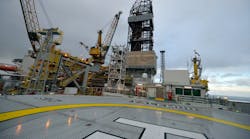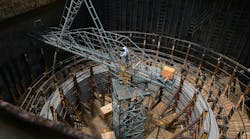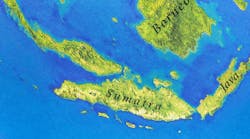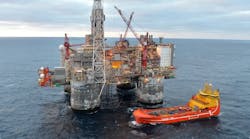Editor's note: This story first appeared in the July-August 2022 issue of Offshore magazine. Click here to view the full issue.
By Jeremy Beckman, Editor, Europe
BRAZIL’S GOVERNMENT AND PETROBRAS are steadfast and unapologetic in their commitment to long-term offshore oil and gas production. Both, however, also see scope for an integrated energy approach involving expansion of Brazil’s renewable energy capabilities into offshore wind and hydrogen, alongside carbon capture and storage in the Santos basin. A recent seminar in London, "Going Green: The future of the oil & gas sector in Brazil," addressed these issues and some of the planned initiatives.
Rafael Bastos, Secretary for Petroleum, Natural Gas and Biofuels at the Ministry of Mines and Energy said more than 15 FPSOs should start operating in Brazilian waters by 2025, most in the presalt. More should follow, with the petroleum agency ANP having approved 11 additional pre-salt blocks for inclusion in the production-sharing regime in the next bid round, likely to be staged in September. Four of these blocks are in the Campos basin and seven in the Santos basin, with a combined 27 Bbbl of unrisked resources by the ANP’s estimate. Norte de Brava, at $104.4 million, commands the largest signature bonus.
Much of the Brazilian offshore remains unexplored, Bastos stressed, with open acreage across the country’s sedimentary basins totaling 7.5 million sq m; less than 5% has so far been awarded, and more than 1,000 exploratory blocks remain on offer. Over the longer term there are opportunities for any size of company, he added, “with high potential in the frontier Equatorial Margin, Amazonas and Pelotas regions. Pelotas [off southeastern Brazil] is our particular focus due to the new discoveries on the West African side offshore Namibia, which is geologically related to the Pelotas basin.” At the same time, the government and ANP are pushing for improved recovery in mature fields.
“In the gas sector, we have opened competition through federal and state regulations and the removal of barriers, Before, there was only one company, now there are seven suppliers in gas distribution. Also new LNG terminals are emerging across Brazil, with access to third parties for natural gas processing.
“The energy transition is a flexible process: Brazil has long experience in renewables, having developed the world’s cleanest energy (biofuels, hydropower), with major projects planned in solar energy, wind, and hydrogen. And the government aims to increase the use of biofuels further – this strategy can be more energy-efficient than electric vehicles with batteries. But to ensure Brazil’s energy security, we also need to continue with oil and gas, there is no other way.” The government is supporting initiatives for future electrification of offshore production facilities, targeting projects with a combined power output of over 80 GW of power. “Integration of fossil fuels with renewables, this is the future,” he concluded.
Rodolfo Saboia, Director General of ANP, gave the agency’s perspective on Brazil’s oil and gas prospects. This year production should reach 3 MMb/d of oil, rising to 5.2 MMb/d by 2030, he said, adding that “Brazil has the potential to be the world’s fifth largest producer. We do believe in a balanced energy transition, fossil fuels and renewables. However, a lot of investment is still needed in the renewable energy sector around the world because what renewable energy is producing is far from what is needed to offset the energy shortfall caused by the conflict in eastern Europe.”
Since 2017 the ANP has staged 15 bidding rounds and these have led to improvements as well as production increases in the pre-salt, where to date more than 50 Bboe has been discovered, he continued. “At the same time, there is a need to have the right assets in the right hands. Petrobras has been transferring certain[mature] assets to smaller companies with different profit profiles. These transfers have been very successful, helping Brazil to increase its overall recovery factor by 10%. But this is low compared to the global average – we need to raise it via investment, and by cutting opex costs. And we want to see more marginal discoveries developed: one of the ANP’s priorities is to incentivize this type of development.”
Saboia also noted that the change of ownership in some of the post-salt shallow water fields had led to a 30-50% reduction in emissions from the facilities. But the entire sector is relatively “clean” by international standards, he stressed. “Since 2008, Brazil’s production has risen by 40%, with no increase in emissions. And in the pre-salt fields, the carbon intensity is typically 10 kg of CO2 per barrel of oil produced, against the global average of 26 kg/bbl.”
Brazil’s move towards a more competitive gas market should help its natural gas production to almost double by 2030, he predicted. “Gas has a major part to play in the energy transition: currently Brazil only uses 45% of the gas it produces, we want to raise that level much higher.”
Heloisa Borges, Director of the Petroleum, Gas and Biofuels Division at EPE (Empresa de Pesquisa Energetica) in Rio de Janeiro, said “a de-carbonized future is not a future without hydrocarbons, and future electrification is not about electrifying everything. Renewable energy currently represents 49% of Brazil’s energy mix: the country will produce more energy, but we will retain that percentage level by 2030, although with new and sustainable goals.”
As presalt oil production continues to climb, EPE hopes to have new players joining this sector in future, Borges said. Brazil’s gas production is also ramping up, mainly in the pre-salt, while gas injection has risen by more than 100% in the past 10 years, from 56 MMcf/d to the present 136 MMcf/d. Finding a more productive use for the gas remains a dilemma, she admitted: “We have the resources, but Brazilian industry still uses a lot of biofuels and wood...
“The energy transition will be very competitive; however, Brazil feels there is not just one single route to get there. We need to combine this with Brazil’s oil and gas: we have the technical capability for synthetic fuels, hydropower, oil and gas, a great supply of different energy resources. The challenge is how to harness it all to create a cleaner future…
“We have reached our capacity with hydro, now we need to move forward with solar and wind energy…We have very good perspectives on offshore wind in Brazil, although we still see gas as critical to our energy security. And gas also allows you to produce clean biomethane or hydrogen without losing the investment – you shouldn’t get locked into one fuel or energy source that you might regret in future. Gas is important not just for long-term security, but also for the transition path.”
While Europe in particular is on the lookout for new sources of gas, Brazil remains an importer of gas, Saboia pointed out, and cannot help in this regard. Nor does the country have the infrastructure to export its gas, Borges noted. “Whether we add this long term depends on the market: we do have the potential to produce more natural gas, but it requires a clear economic incentive for investors to invest in the infrastructure to make this happen. The Espirito Santo basin and the Wahoo field in the Campos gas basin have some gas potential, likewise the pre-salt Santos basin – the question is, how do we create incentives for people to use that gas?
Roberto Ardenghy, former Chief Sustainability Officer at Petrobras, now an Energy Diplomat, said it was important to take into account the cost of the energy transition: for 750 million people around the world there is still no access to any form of energy, he pointed out. “Oil and gas still has an important part to play in developing new sources of energy, there are $23 trillion of assets globally related to oil and gas. Do we just get rid of these and replace them with another kind of energy?
“There is a lot of efficiency still to be worked into the oil and gas sector. Brazil has oil which is very low in emissions, 40% less carbon emissions than the world average. If Brazil stopped tomorrow producing oil, the replacement oil would increase global emissions. So we need to invest more in decarbonizing, seeing what technologies are available. Brazil has one of the world’s largest carbon capture and injection projects [at the deepwater Tupi field in the Santos basin]. The 2MMb/d from the pre-salt has a very low sulfur content – if we added to this carbon capture, we would have a very good, low-carbon oil to offer the world.”
Pedro Brancante, Head of External Relations at Petrobras, said his company was looking to be a low-carbon producer, targeting 16.5 kg/ CO2e per bbl from its overall operations. “Our emissions per barrel have come down by nearly 50% in the past 11 years, despite the 40% rise in oil and gas production over the same period. And in the large pre-salt fields, the percentage is now 10 kg CO2e/boe, compared with 30 kg/ CO2e/boe in 2009.”
Petrobras is progressing its Net Zero-ambition Scope 1 and 2 activities in a timeframe compatible with the Paris agreement, he added, its goals including zero routine flaring by 2030, and a 32% reduction in carbon intensity in upstream operations by 2025. The company has also established a decarbonization fund of initially $248 million for developing new solutions, studies, and implementing schemes to mitigate carbon emissions without affecting projects’ NPV, and spearheading a carbon mentality in the organization. And although there is no regulated carbon market in Brazil, the government is working on an initiative, supported by Petrobras
HISEP is a high-pressure, dense-phase separation process patented by Petrobras that enables separation and reinjection of CO2-rich associated gas on the seabed, lessening the requirement for space-consuming gas processing modules on the FPSO topside and reducing CO2 emissions. The consortium in the ultra-deepwater Libra block in the presalt Santos basin has agreed to conduct a pilot test in the Mero 3 area: Petrobras may by now have appointed the supplier of the subsea pumps that will reinject the gas into the reservoir for the trials, with the equipment potentially installed offshore by 2025.
“In future,” Brancante said, “we could create a CCUS hub, collecting CO2 produced from steel, cement, biofuels onshore, re-used for enhanced oil recovery in our ultra-deepwater reservoirs. We’re working with various start-ups and Petrobras’ research center to achieve this. We’re also exploring offshore wind off the Brazilian coast, in a partnership with Equinor. Recently the two companies signed a Memorandum of Understanding for a future offshore wind project, but with no deadline for the installation as the Energy Ministry is still setting rules for offshore wind. The MoU could also set the stage for combining oil and gas production from existing facilities with the generation of offshore wind energy.” Petrobras has conducted its own early-stage research into wind energy and new turbine technology, he added.
Porto do Açu offers 17 km of quayside and has 3 GW of installed power capacity, which it is licensed to double. PABI, in association with the port’s owners, is now looking to bring in offshore wind and hydrogen, with the capability to export to Brazil’s grid. “We’re looking to attract the global players in offshore wind licensing, Atkin said. “We see a 20 GW potential for offshore wind at the port, with an area available to manufacture wind components. We also aim to produce green and blue hydrogen, fed into the national grid or used by industry at the port; or for export, potentially helping to address European demand for energy.” Shell Brazil is looking to develop a green hydrogen plant at the port, he added, and production could begin in 2025.









